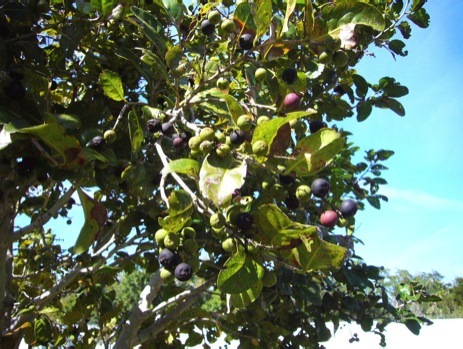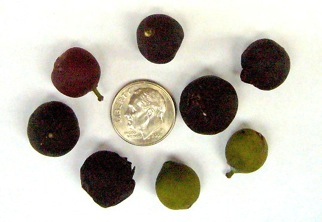Coccoloba diversifolia: Seagrape Sibling
The first time you see a Pigeon Plum it will look familiar. In the same genus as the Seagrape it shares a family resemblance. In fact, it’s also called Pigeon Seagrape along with Dove Plum and Tie-tongue.
Like many plants (or siblings) who have a more famous relative the Pigeon Plum is in the shadow of the Seagrape (did you know Princess Grace Kelly’s brother and father, John Jr. & John Sr., were both Olympic gold medalists?) While both the Seagrape and Pigeon Plum can be eaten out of hand, the latter benefits from being allow to dry then rehydrated. The fruit is eaten or made into jelly or wine. The jelly tastes almost identical to apple jelly. Some folks in the Caribbean make the Pigeon Plum into a very potent distillation. Because of the astringency the berries store well but earned them the common name of Tie-tongue. They are often sold in Caribbean markets and were an important food for the Mikasukis Indians.
Botany Lesson Boardering On Boring: The scientific name of the tree is Coccoloba diversifolia ( koe-koe-LOE-buh dye-ver-sih-FOLE-ee-uh). Coccoloba comes from “coccum” which is Dead Latin for “berry, and loba meaning lobe. Diversifolia means different leaves which in this tree can mean pointed tips or a round tips. The leaf stems (petioles) also appear to wrap around the main stem with a clasping ring, a unique feature. The berry is actually an achene (ay-KEEN, not uh-KEEN) which is from the Greek ἀ + χαίνειν (HAY-neen from χαίνω, HAY-know) meaning to gape. As used it means a small dry, hard, one seeded indehiscent fruit. Indehiscent (in-duh-HISS-ent) means not opening at maturity (to release its seed or seeds.) Although the Pigeon Plum fruit and the Sunflower seed in a shell are very different — one fleshy and one hard — they are both indehiscent and achenes; there is a gap between the seed and its outside and the outside does not open to release the seed. I would add the fruit of the cabbage palm as well as an example of an indehiscent fruit and an achene. Another way of saying is “it looks like the seed shrunk inside.”
The Pigeon Plum is an upright tree with dense leaves and evergreen but it can dump a lot of leaves around March putting on new red ones. Flowers are three-inch long racemes (spikes) in early summer turning into multiple 1/3 inch peach-shaped green fruit that ripen to dark purple that persist on the tree. While usually 25 to 35 feet at maturity it can grow larger. Young trees look pyramidal but then the tree usually develops multiple trunks which can make older trees look like rounded vases.
In the Buckwheat family this tree was used for centuries to produce a tannin called Kino that was used medicinally. Now it is mostly an ornamental plant producing what some call a marginally edible fruit. That is a bit puckish. If it were the only fruit in season and your only choice it would be a great fruit of many uses. But if one has hundreds of fruits most bred to be sweet and inoffensive then it becomes a marginal fruit. As mentioned, dried “plums” rehydrated are the best tasting. It is not unusual in non-commercial fruit trees that the best fruit are the ones you have to fight the ants for.
If modern man has taste issue with the tree, birds do not, especially pigeons and doves, which is why it is called Pigeon Plum and Dove Plum. Bird watchers know to find that tree to sight those birds. (An accessible specimen grows in Dreher Park in West Palm Beach, FL, just east of the Zoo.) More so, the fruit can ferment on the tree. Ethnobotanist Dr. Daniel Austin in his book Florida Ethnobotany reports seeing a Mocking Bird once drunk on Pigeon Plum fruit. Among the other wildlife that visit the tree are catbirds, robins, woodpeckers, small rodents and raccoons.
In Florida, you can find the Pigeon plum in coastal central and southern Florida from Brevard County south through the Keys and into the counties of Indian River, St. Lucie, Martin, Palm Beach, Broward, Miami-Dade, Monroe, Collier, and Lee. It also grows in the Bahamas, throughout the Caribbean, in Puerto Rico and the Virgin Islands.
Green Deane’s “Itemized” Plant Profile
IDENTIFICATION: Tree to 70 feet, usually half that size or less. Straight trunk compact head. Branches don’t droop. Bark light gray, on older trees flaking in large scales. Leaves, alternate, simple, no teeth, oblong to ovate, some blunt tips, some pointed tips, pinnate, evergreen, two to four inches long. Flowers creamy-white spike. Fruit dark purple. oval to pear shaped, in clusters, thin-fleshed, juicy, can be astringent, single hard seed resembling a Seagrape seed. Mostly dark brown with pointed tip.
TIME OF YEAR: Fruits fall to winter
ENVIRONMENT: Full sun, can tolerate some shade, drought tolerant, can tolerate some salt, found mostly in coastal areas.
METHOD OF PREPARATION: Eaten raw, made into jelly, wine or distilled spirits. Raw fruit better if dehydrated some first, better cooked if rehydrated first.



